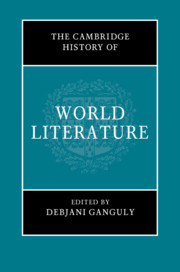Book contents
- The Cambridge History of World Literature
- The Cambridge History of World Literature
- Copyright page
- Contents
- Figures
- Contributors
- Acknowledgements
- Introduction
- Part I Genealogies
- Part II Thinking the World
- Part III Transregional Worlding
- Part IV Cartographic Shifts
- Part V World Literature and Translation
- Part VI Poetics, Genre, Intermediality
- 31 Poetry, (Un)Translatability, and World Literature
- 32 The Reinvention of the Novel in Africa
- 33 The Return of Realism in the World Novel
- 34 The Graphic Novel as an Intermedial Form
- 35 World Children’s Literature
- Part VII Scales, Polysystems, Canons
- Part VIII Modes of Reading and Circulation
- Part IX The Worldly and the Planetary
- Index
- References
34 - The Graphic Novel as an Intermedial Form
from Part VI - Poetics, Genre, Intermediality
Published online by Cambridge University Press: 17 August 2021
- The Cambridge History of World Literature
- The Cambridge History of World Literature
- Copyright page
- Contents
- Figures
- Contributors
- Acknowledgements
- Introduction
- Part I Genealogies
- Part II Thinking the World
- Part III Transregional Worlding
- Part IV Cartographic Shifts
- Part V World Literature and Translation
- Part VI Poetics, Genre, Intermediality
- 31 Poetry, (Un)Translatability, and World Literature
- 32 The Reinvention of the Novel in Africa
- 33 The Return of Realism in the World Novel
- 34 The Graphic Novel as an Intermedial Form
- 35 World Children’s Literature
- Part VII Scales, Polysystems, Canons
- Part VIII Modes of Reading and Circulation
- Part IX The Worldly and the Planetary
- Index
- References
Summary
This chapter deals with the specific role and place of the graphic novel in the contemporary literary field. It first addresses the widely debated analogies and differences between comics and graphic novels, while making a clear plea for the autonomy of the latter. It then studies the history of the graphic novel, with a strong emphasis on questions of publication format and cultural reception. Finally, it also discusses the question of canon formation and the relationships between mainstream and minority cultures in the field.
- Type
- Chapter
- Information
- The Cambridge History of World Literature , pp. 653 - 667Publisher: Cambridge University PressPrint publication year: 2021

